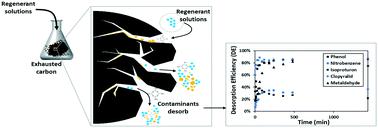当前位置:
X-MOL 学术
›
Environ. Sci.: Water Res. Technol.
›
论文详情
Our official English website, www.x-mol.net, welcomes your feedback! (Note: you will need to create a separate account there.)
Chemical regeneration of granular activated carbon: preliminary evaluation of alternative regenerant solutions
Environmental Science: Water Research & Technology ( IF 5 ) Pub Date : 2020-06-15 , DOI: 10.1039/d0ew00328j Amanda Larasati 1, 2, 3, 4 , Geoffrey D. Fowler 1, 2, 3, 4 , Nigel J. D. Graham 1, 2, 3, 4
Environmental Science: Water Research & Technology ( IF 5 ) Pub Date : 2020-06-15 , DOI: 10.1039/d0ew00328j Amanda Larasati 1, 2, 3, 4 , Geoffrey D. Fowler 1, 2, 3, 4 , Nigel J. D. Graham 1, 2, 3, 4
Affiliation

|
Granular activated carbon (GAC) is used in drinking water treatment plants worldwide to remove micro-pollutants such as pesticides. Early breakthrough of problematic micro-pollutants leads to frequent and costly thermal regeneration off-site. A potential alternative approach is to chemically regenerate GAC on-site (possibly in situ) with an appropriate solution capable of desorbing organic contaminants, having a range of physico-chemical properties. In this study, four types of regenerant solution were evaluated in batch tests for their ability to desorb five target contaminants. The solutions were: high purity water, sodium hydroxide, ethanol, and a mixture of sodium hydroxide and ethanol. The contaminants included: phenol and nitrobenzene, as representative aromatic compounds; clopyralid and metaldehyde, as poorly-adsorbed pesticides; and isoproturon, a well-adsorbed pesticide. Among the properties of the contaminants, their hydrophobicity and aqueous solubility had the most significant influence on the desorption efficiency. NaOH/CH3CH2OH was found to be more effective than individual solutions in desorbing the target contaminants, indicating an ability to desorb both hydrophobic and hydrophilic compounds. The NaOH/CH3CH2OH regenerant solution yielded desorption efficiencies in the range of approximately 40–90%, with the efficiency dependent on the contaminant. A thermodynamic study provided valuable fundamental information regarding the adsorption and desorption mechanisms, and the existence of two binding sites involving a weak physisorption and a stronger chemisorption-like interaction between the contaminants and the GAC.
中文翻译:

粒状活性炭的化学再生:替代再生溶液的初步评估
颗粒状活性炭(GAC)在全球的饮用水处理厂中用于去除农药等微量污染物。有问题的微污染物的早期突破导致异地频繁且昂贵的热再生。一种潜在的替代方法是在现场(可能在原位)化学再生GAC)的溶液,该溶液能够解吸有机污染物,并具有一系列的物理化学性质。在这项研究中,在批处理测试中评估了四种类型的再生剂溶液解吸五种目标污染物的能力。溶液为:高纯水,氢氧化钠,乙醇以及氢氧化钠和乙醇的混合物。污染物包括:苯酚和硝基苯,作为代表性的芳香族化合物;以及 氯吡醛和甲醛,吸附性较差的农药;和异丙隆,一种吸附良好的农药。在污染物的特性中,它们的疏水性和水溶性对解吸效率有最显着的影响。NaOH / CH 3 CH 2发现OH在解吸目标污染物方面比单独的溶液更有效,表明具有解吸疏水性和亲水性化合物的能力。NaOH / CH 3 CH 2 OH再生剂溶液的解吸效率约为40-90%,其效率取决于污染物。热力学研究提供了有关吸附和解吸机理以及存在两个结合位点的有价值的基本信息,这两个结合位点涉及污染物与GAC之间的较弱的物理吸附和较强的类似化学吸附的相互作用。
更新日期:2020-07-31
中文翻译:

粒状活性炭的化学再生:替代再生溶液的初步评估
颗粒状活性炭(GAC)在全球的饮用水处理厂中用于去除农药等微量污染物。有问题的微污染物的早期突破导致异地频繁且昂贵的热再生。一种潜在的替代方法是在现场(可能在原位)化学再生GAC)的溶液,该溶液能够解吸有机污染物,并具有一系列的物理化学性质。在这项研究中,在批处理测试中评估了四种类型的再生剂溶液解吸五种目标污染物的能力。溶液为:高纯水,氢氧化钠,乙醇以及氢氧化钠和乙醇的混合物。污染物包括:苯酚和硝基苯,作为代表性的芳香族化合物;以及 氯吡醛和甲醛,吸附性较差的农药;和异丙隆,一种吸附良好的农药。在污染物的特性中,它们的疏水性和水溶性对解吸效率有最显着的影响。NaOH / CH 3 CH 2发现OH在解吸目标污染物方面比单独的溶液更有效,表明具有解吸疏水性和亲水性化合物的能力。NaOH / CH 3 CH 2 OH再生剂溶液的解吸效率约为40-90%,其效率取决于污染物。热力学研究提供了有关吸附和解吸机理以及存在两个结合位点的有价值的基本信息,这两个结合位点涉及污染物与GAC之间的较弱的物理吸附和较强的类似化学吸附的相互作用。


























 京公网安备 11010802027423号
京公网安备 11010802027423号